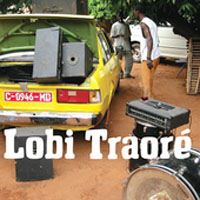
LOBI TRAORE
THE LOBI TRAORE GROUP (Honest Jons HJRCD13)
I thought Lobi Traoré was one of the mellow older generation of Malian acoustic guitarists but he hits the ground plugged-in and running in this outing and doesn't stop till you are exhausted. Now in the post-Ali Farka era he has to contend with Mama Sissoko, Sekou Bembeya Diabaté and Djelimadi Tounkara for fastest guitar in the West. He leaves no doubt he is a contender. The liner notes of this handsome package are succinct: "Recorded October 2002, outdoors in Bamako City. Continuous takes, no overdubbing." That says it all. There's Lobi on electric guitar and vocals, two bass players (I guess the first one wore out), balafon, traps and djembe. It is a smoker. You can hear the balafon clearly and it is not just hammering a continuo, Modibo Kouyaté solos like a dervish and takes the lead while Lobi chords and does some wild experimenting. In fact Lobi is great at holding down some trance-inducing riff to let the balafon solo and then break into an inspired lead, equal parts Jeff Beck, Ali Farka, Sonny Boy Williamson, and sorcery. Meanwhile the djembe player, Boubacar Sissoko, is no slouch. That doesn't leave much for the drummer who works his foot pedals keeping up a hissing high-hat and bass drum bomp to ground the rhythm while Lobi takes flight.
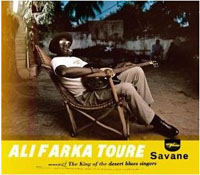
ALI FARKA TOURE
SAVANE (World Circuit/Nonesuch 79965-2)
Ali Farka Touré's final recordings are lovingly presented here by World Circuit. The sound is great, the booklet exceptional (with photos & lyrics in translation). In addition to a large ensemble including Mama Sissoko and Bassekou Kouyate on dueling ngonis, there's the haunting sax of Pee Wee Ellis on "Beto," and "N'jarou." Harmonica, violin and flute on other tracks add variety. This is really well-sequenced because it sounds like several different groups and comes across more as a tour of the savannah than the work of one artist. All his protestations to the contrary, Touré's guitar does recall Mississippi delta blues. There are echoes of Fred MacDowell made exotic by the kora fills sprinkled throughout. On "Ledi Coumbe," Little George Sueref's harmonica also forcibly suggests the deep south. Though everyone has their favourite Ali Farka Touré album, I think this is perhaps his finest work and a great monument to the Malian giant who died in Summer 2006.
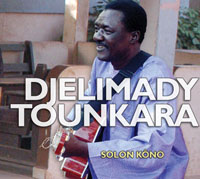
DJELIMADY TOUNKARA
SOLON KONO (Marabi 46810.2 Harmonia Mundi)
You may be thinking, Hmmm, another Malian acoustic guitar album, but if you have heard Djelimady play solo acoustic guitar you know he is ace. Best known as the driving force behind the Super Rail Band de Bamako, Tounkara is unquestionably one of the most versatile guitarists living. He is influenced by flamenco, and that's apparent from the opening cut: a virtuoso piece of Spanish-style playing. This album is mellow yet bristles with energy. There are even two electric tracks for the Rail Band fans who need a shot of that endless line of burning steel running through the sands. One of them, "Sarankégni," is a reworking of a very early Rail Band hit when Mory Kanté was the singer. It's delivered in a beautifully reconsidered rendering sung by his youngest daughter Mariam Tounkara. Recorded in Bamako's Studio Bogolan where the redoubtable Yves Wernert twiddles the knobs, Djelimady is backed by family members and a new band of fresh recruits to the Malian trad music scene. The djembe and doundoun are undermiked, to keep the guitar forward in the mix, and the singers on top. Young Mountaga Diabaté from the Rail Band is the featured singer. SOLON KONO is the perfect demonstration of traditional music in a modern context.
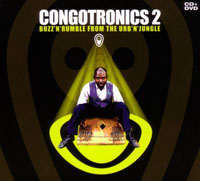
CONGOTRONICS 2
Buzz 'n' Rumble from the Urb'n Jungle (Crammed Disc CRAW29)
This came out in Europe in 2005 but took a long time to get here. I have to say it is truly mind-blowing. If Konono's debut album was hot then a disc with seven of these electric likembe outfits has got to be jamming, right? Masanka Sankayi, the Kasai Allstars, Sobanza Mimanisa, Kisanzi Congo, Bolia wa Ndenge, and Basokin also perform; they are folkloric troupes from all over the Congo basin who have ended up in the big city, using home-made sound systems that create massive distortion, as well as some improvised instruments conjoined to traditional xylophones and thumb pianos and a battery of bottles and drums. The 41-minute bonus DVD shows the bands during the recording session and makes a virtue of the amateurish quality of the shaky hand-held camera work. In fact, the editing by Elsa Dahmani (daughter of "Latcho Drom" filmmaker Tony Gatliff) is a crash course in how to take crappy raw material and make it look good. The film reinforces what you guess from the music, that it is visceral raw roots music and has been modernised without losing its authenticity. Sure there are American college sweatshirts visible, but they are warmer than grass skirts. (Oxfam has dumped so much clothing on East Africa that is has put the local tailors out of business.) Like the sense of style, the music evolves. Electric bass plays the part you might have imagined on the lokolé or slit log drum. You still have a groove that wont quit & that vertiginous feeling you get from narcotics. (If you have never inhaled narcotics imagine listening to music on headphones, drunk, laying on your back on a waterbed. -- Come to think of it, if you've never inhaled narcotics you've probably never been anywhere near a waterbed.) Let's just say the insistence of the music takes over your brainwaves and causes a kind of euphoria. You don't need drugs: the music quickly puts you into a trance (& it's kinder to your liver).
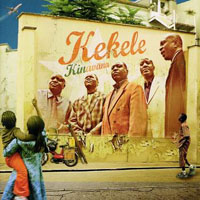
KEKELE
KINAVANA (Stern's STCD1101)
Kékélé consists of the most accomplished Congolese musicians still standing from the great proto-soukous wave of twenty years ago. They've mellowed, unplugged and now reflect on their roots with KINAVANA, their third and most successful outing to date. To the flexible all-star roster of front-line talent they've added a solid Latin underpinning (arranged by Nelson Hernandez) of flute and strings to give a charanga backing to their exploration of the work of some of Cuba's great folk composers. It's not Buena Vista revisited, nor Africando, as you might think, because they are not singing in Spanish. In fact they have taken the original lyrics and phonetically transposed them to Lingala to create new lyrics, so Nico Saquito's "Oye mi son" becomes "Yoka biso." This is also a part of the heritage as the reincorporated Cuban sones of the 1930s were adapted to the Congo style with the violin and piano parts transposed to electric guitars. As Ken Braun notes, it wasn't so much appropriation as a repossession of something the Congolese realised was inherently theirs. In addition to the full sound provided by strings and horns, the return of Papa Noel (after an enforced absence due to illness) is welcome. Mbilia Bel adds her sweet ethereal voice to a couple of numbers and the great hippo-voiced Madilu also shows up. Manu Dibango plays sax on five tracks. Richard Virnet's muted trumpet is more New York than Santiago, adding a nice splash of urban sophistication to the metropolitan mix, especially on "Yo odeconer" (a reworking of Nico Saquito's classic "Al vaiven de mi carreta"). Syran and Papa Noel rise to the occasion pulling off some brilliant interplay on their Spanish guitars.
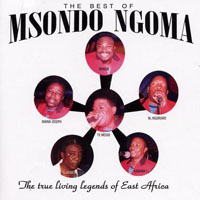
MSONDO NGOMA
THE BEST OF MSONDO NGOMA (Ujamaa Records, available through STERNS)
Subtitled "The true living legends of East Africa," this is quite a remarkable, not to say magic disc. Tanzanian dance band music is some of the finest, most enduring popular music to come out of Africa. Sure there are fads for soukous, bikutski, salsa Africana, mbaqanga, but they seldom last more than a decade at most, so it's no small wonder that this group has endured and still sound so good. The trail-blazing band was formed in 1964 as N.U.T.A. Jazz Band, named for the National Workers Union. Their ZILIZOPENDWA or OLD IS GOLD albums on Polygram are classics. But their lead singer Hassani Bitchuka and lead guitarist Abel Balthazar defected to form Mlimani Park and the group reformed as Juwata Jazz. In 1991 the two defectors returned to the ranks and the band crystallized as O.T.T.U. Jazz, so-named for their new sponsor, the Organization of Tanzanian Trade Unions. You will recognize "Tupa Tupa" as it's on MUZIKI WA DANSI. Here it's a different take, a sharply silhouetted safari over familiar terrain carried off with flair. The songs are in Swahili, the sound is old school rumba, with horn choruses, mingling guitar licks, and fine solos and vocals.
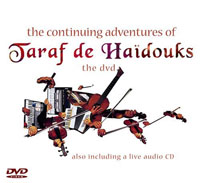
TARAF DE HAÏDOUKS
THE CONTINUING ADVENTURES OF... (Crammed Disc DVD TDH2)
The latest offering from the Romanian Band of Brigands continues with more gypsy hijinks at a breakneck pace. (Even the slow numbers have hidden rapids.) The music is much the same as on their earlier albums but this time there's also a DVD if you need to take it sitting down. The DVD includes concert footage (the same set you hear on the CD), interviews (including Johnny Depp), and a history of the band cobbled together from their own home movies: "No man is a prophet in his own land." Featured is the Taraf's memorable jam session with the Kocani Orkestar and a Bulgarian clarinetist, Filip Simeonov, and other bright moments from their BAND OF GYPSIES recording. During the set, recorded in the atmospheric old Union Chapel in London, there's "Back to Clejani" where the violinist pulls on a horsehair attached to his string which sounds like he is tearing apart the sound. Falcaru (who reminds me of a Pasolini character) plays a storming pennywhistle solo on "Little Buds." "A stork crosses the Danube in the company of a raven," has a spot for everyone (except for Viorel, the great double bass player) to solo, my favourite being the cembalom player Cristinel Turturica. There's a very inspired breakdown in the encore, "Briu opsa," where they all start making animal and bird sounds on their instruments before rejoining one last speedy chorus. Sure it's shtick, but here it works well. Three of the songs are recorded here for the first time. It's essential listening (& viewing) for gypsy music fans and, if you haven't hooked up with the Haïdouks yet, here's a great place to start.
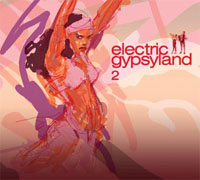
ELECTRIC GYPSYLAND 2 (Crammed Disc Craw37P)
Sequels usually sop up the dribbles from a great album, but here is a sequel that's every bit as good as the great first album. ELECTRIC GYPSYLAND 2 is a collection of remixes from three of the top Balkan Gypsy bands (Taraf de Haïdouks, Koçani Orkestar and Mahala Raï Banda). Gaetano Fabri & Shantel are the only mixologists to return from the first disc which was my top album of 2004 with its endless surprises and great variety of styles. Balkan Beat Box, Oi Va Voi, & Smadj show up with some recruits from the Balkan club scene (DJ ClicK, Forty Thieves Orkestar, Russ Jones, Russendisko), and there are wilder contributions such as 43 Skidoo featuring Susheela Raman, or Buscemi, best known for reworking Brasilian beats, and ShrineSynchroSystem. Many additional guest musicians (from Europe, Turkey, Africa), add overdubs to extend the sound and re-imagine the gypsy riffs for the club milieu. In addition there's a bonus disc that is the best gypsy sampler I have heard to date. In fact it's great to have the raw material these remixes were made from because they are occasionally far-out, and the original tracks by Taraf de Haïdouks, Koçani Orkestar, Mahala Raï Banda & (new to me) Zelwer cleanse your palate and prepare you for further immersion in the electric antics.
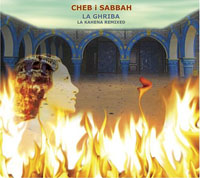
CHEB I SABBAH
LA GHRIBA: LA KAHENA REMIXED (Six Degrees 657036)
It's an inevitable as spring follows winter -- or around here, winter follows spring -- the Remix album. The latest from the "Young Man of the Mountain" is a set of oldies in a new galabieh: Cheb i Sabbah gave his raw material to some other master mixologists and like a chain letter they sent back their take on his latest set of tunes. I asked him whether the artists were all people he knew. Yes, he says, and they mostly wanted the original "dry" track, without any of his own effects or add-ons. But this is quite easy, he tells me, with the technology that is used today. "A couple of people took little sections and built up a whole structure but all they wanted was a snippet." I asked him about the distribution of songs since obviously the most catchy tunes would be most popular. "Toura toura" and "'Esh dani, alash mshit" were the most popular. The latter, which was remixed by Temple of Sound and Bill Laswell, reminds me of "Truckin'" by the Grateful Dead, I told him, as it has a catchy refrain that keeps chugging back. "Maybe I could get one of the Dead guys to remix it," he joked, "then I wouldn't have to worry about the rent!" Moroccan artists Ahderrahim Akkaoui and Pat Jabbar, known as Dar Beida 04, picked the hardest song, he tells me, and came out with a trance vibe. "Not many venture the hardest tracks: if it's more catchy they think they can do something with it. Bassnectar wanted to do 'Alkher illa doffor' which was cool because no one else wanted to do that one. If you like break-beats it works." We talked about remix albums in general. He told me so many sound the same. "It sounds like Logic," is a deejay in-joke because of the beginners who let the inherent sound of the software dominate the result. Cheb i Sabbah likes the latest from Bally Sagoo and thinks he did a fine job trying on different styles, like House, but he doesn't like Balkan music because the brass instruments grate on him, so he didn't get into ELECTRIC GYPSYLAND. We also differ on Bally Sagoo, whom I find very inconsistent. "The big names were cool at first but then the interns took over, and so often it shows," he says, referring to the stratosphere of remix jockeys. On LA KAHENA REMIXED, he says, "There are 11 remixes here but 11 different kinds of sounds. Each track has an individual sound, so I was happy overall. I am not expecting everybody to love the trance tracks AND the break-beats, but overall it represents pretty much the dance scene as of today. -- Well, there's no House, but who needs more House?"
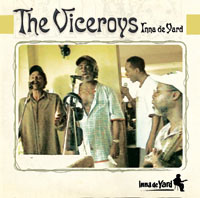
VICEROYS
INNA DE YARD (IDYCD005)
The "Inna de yard" series is a new venture from French label Magasound. Their mandate is to record Jamaican artists in an informal setting, basically jamming in their back yards. I jumped on this because I love the Viceroys' album YA HO which was a Heartbeat compilation of some of their early Studio One work. Formed in 1968, they are a classic Jamaican vocal harmony group with a lot of resonance from American Do-Wop and Soul. I love the conjunction of sweet harmonies and a pumping reggae beat, like on "Last night," and the bubbly organ & rootical bass on their hit "Ya ho" (with its simple lyrics about pirates --"Sixteen men on a dead man's chest"-- sound familiar?). Wesley Tinglin, lead singer and composer, also came up with Rasta ditties like "Love Jah" and "Slogan on the wall," and on this outing sticks more to the Rastafarian anthems of the '70s (which have never been compiled before). The album opens with "Heart made of stone" accompanied by only Tinglin's understated vamping on acoustic guitar. This was his 1980 hit, produced by Sly & Robbie. Then after a-one and a-two, they break into a fantastic version of "Ya ho," with throbbing bass and half a dozen hands slapping drums. Chinna Smith plays a scratchy guitar. They do "Mission Impossible," which was originally their hit backing Winston Riley as the Interns, with flute & organ; it is so tight it sounds like a studio recording. "I guarantee my love" lacks the youthful pep of the original and the mix is out of kilter, however the "Inna de Yard" authenticity saves it. The vocals are strained on "Last night" because it is pitched too high, but it is redeemed by live dubbing by Chinna, Bo Pee & Sangie's guitars (without any effects). You can't imagine a Reggae band who don't do a version of "Satta massagana," and the Viceroy's "Shadrach, Meshach and Abendigo [sic]" is choice. The album ends quietly with another solo acoustic guitar number.
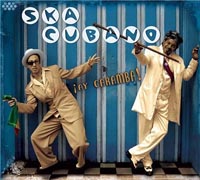
SKA CUBANO
!AY CARAMBA! (Cumbancha CMB CD1)
I think Cumbia Jazz is a more accurate description of this band than Ska Cubano. There's a couple of louche latin lotharios on the cover looking like tryouts for a Cab Calloway costume contest: Natty Bo & Beny Billy. Mister Bo, a retro ska singer & DJ from London, was on a trip to Cuba when he met Señor Villy, a Beny Moré impersonator, singing in a bar. Their voices meld together well and they have a band of hotshots capable of throwing down ska sax, Cuban tres, Cumbia piano, whatever it takes. The result is greatness. They take a different tack from New York Ska Jazz Ensemble, heading more towards a pre-bebop 1940s jazz sound which they achieve with smoothness and suavity. My favourite tracks, though, are the cumbias which they invest with vigour and great humour (not to mention shrieking trumpet and dancing clarinet), and the novelty numbers ("Big Bamboo" & "Istanbul," a music hall song from the 1920s). Among the ska tracks, a wild treatment of Beny Moré's "Marianao" stands out for romping excitement. "Chispa tren," an original composition by Bo, tilts towards Raymond Scott & is an aural delight with its knackered mechanism and cartoonish joie de vivre. Frankie Laine's 1951 hit "Jezebel" gets Prince Busterdized. Despite the Tom-Jones-does-Las-Vegas grandiosity of the melody, the band chugs on relentlessly even when Natty seems to be a semi-tone off. (But, then this is two-tone music, right?) Haitian santeria is up next. Is nothing sacred?! The ritualistic merengue "Bobine" comes across with dead certainty & a deep understanding of the traditions of Caribbean praise-singing. To end there's the icing on the cake: "Cumbia en Do menor," a hit for Lito Barrientos that I discovered through the great MEN WITH GUNS soundtrack. Sophisticated pan-Caribbean cut-ups with lots of jazz and love.